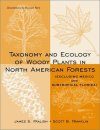About this book
Provides complete keys to identifying North American trees and shrubs based on leaf shape, twigs and fruits. Separate keys are provided for each region of the US, along with basic taxonomic concepts and methods.
Contents
Preface; 1. Introduction to Taxonomy; 2. Introduction to Forest Ecology; Part I: Taxonomic Concepts and Methodology; 3. Plant Classification; 4. Nomenclature; 5. Collecting and Preserving Specimens; 6. Key Construction and Use; Part II: Gymnosperms (Division Pinophyta); 7. The Gymnosperms: An Overview; 8. Gymnosperm Vegetative and Reproductive Structures; 9. Order: Pinales I: Pinaceae: Pinus; 10. Order: Pinales II: Pinaceae: Larix, Picea, Abies, Tsuga, Pseudotsuga; 11. Order: Pinales III: Cupressaceae; 12. Order: Taxales, Ginkgoales, and Cycadales; Part III Woody Angiosperms (Division Magnoliophyta); 13. The Woody Angiosperms: An Overview; 14. The Woody Angiosperm Leaf; 15. The Woody Angiosperm Twig; 16. Angiosperm Flower and Fruit Structures; 17. Class: Magnoliopsida; Subclass: Magnoliidae. Magnoliaceae, Annonaceae, Lauraceae, Calycanthaceae, Aristolochiaceae,; Illiciaceae, Schisandraceae, Ranunculaceae, Berberidaceae, Menispermaceae.18. Class: Magnoliopsida; Subclass: Hamamelidae I. Platanaceae, Hamamelidaceae, Ulmaceae, Moraceae, Juglandaceae, Myricaceae, Casuarinaceae; 19. Class: Magnoliopsida; Subclass: Hamamelidae II. Fagaceae, Betulaceae; 20. Class: Magnoliopsida; Subclass: Dilleniidae. Tiliaceae, Salicaceae, Ericaceae, Clethraceae, Cyrillaceae, Sapotaceae, Ebenaceae, Styracaceae, Symplocaceae, Clusiaceae; 21. Class: Magnoliopsida; Subclass: Rosidae I; Rosaceae, Fabaceae, Elaeagnaceae, Thymelaeaceae, Hydrangeaceae, Grossulariaceae, Iteaceae, Cornaceae, Garryaceae, Nyssaceae, Aquifoliaceae, Celastraceae, Rhamnaceae, Vitaceae, Araliaceae; 22. Class: Magnoliopsida; Subclass Rosidae II; Aceraceae, Sapindaceae, Anacardiaceae, Hippocastanaceae, Staphyleaceae, Rutaceae, Simaroubaceae; 23. Class: Magnoliopsida; Subclass: Asteridae; Oleaceae, Bignoniaceae, Scrophulariaceae, Rubiaceae, Caprifoliaceae, Adoxaceae; 24. Class: Liliopsida (Monocotyledoneae); Arecaceae, Poaceae, Smilacaceae; Part IV: Forest Community Ecology: Combining Species into Communities; 25. Introduction to Forest Ecology and Classification; 26. Forest Environment and Cover Types-Regions 1 and 2: Northern Conifer-Hardwood and Northern Hardwood-Conifer Forests; 27. Forest Environment and Cover Types-Region 3: Central Hardwood Forest; 28. Forest Environment and Cover Types-Region 4: Southern Pine-Hardwood Forest; 29. Forest Environment and Cover Types-Regions 5 and 6: Rocky Mountain Conifer Forests; 30. Forest Environment and Cover Types-Region 7: Northern and Southern Coastal Conifer Forests; Glossary of Technical Terms; Glossary of Genus and Species Names; References; Index of Species; Subject Index
Customer Reviews
Biography
JAMES S. FRALISH, PhD, is Professor Emeritus in the Department of Forestry at Southern Illinois University at Carbondale. SCOTT B. FRANKLIN, PhD, is Assistant Professor in the Department of Biology at the University of Memphis. HYOSUN PARK, BA, is a freelance illustrator and artist living in Milwaukee, Wisconsin.



































